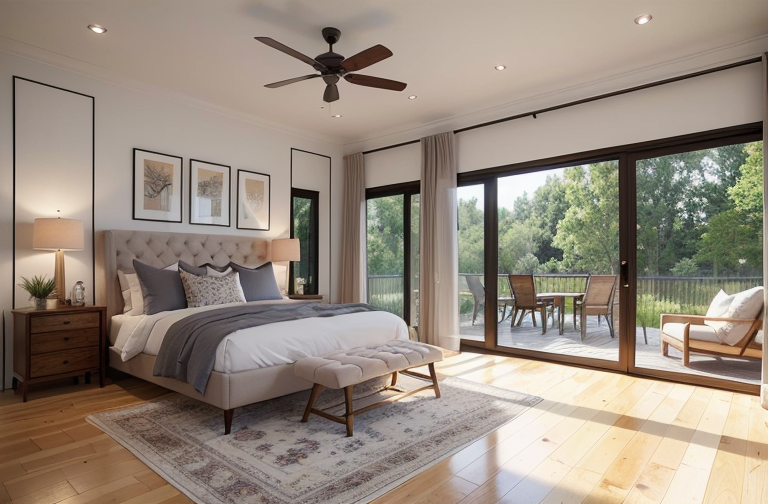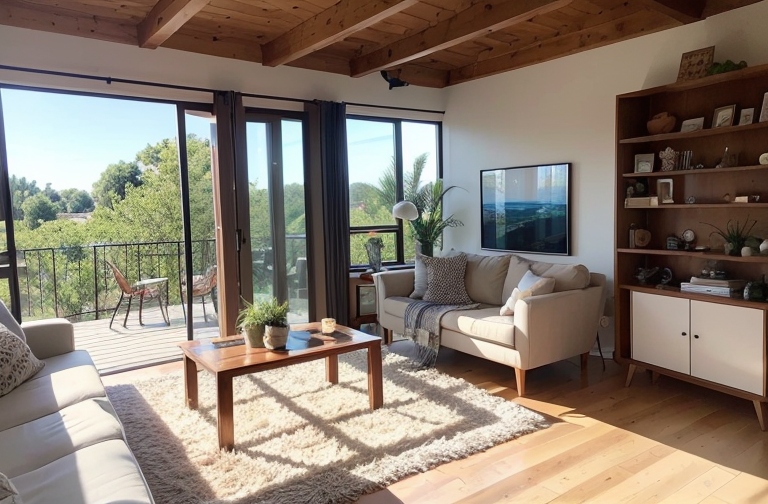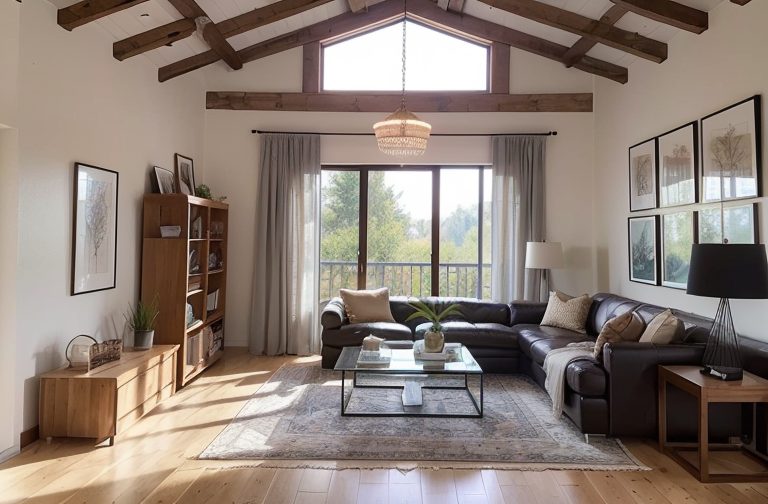Exploring Modern Home Design: Key Features, Aesthetic Elements, and Future Trends

The article provides an analysis of modern home design elements, highlighting the use of neutral colors, natural elements, clean geometry, and open floor plans. It also underscores the expected trends for 2023, such as bold light fixtures and eco-friendly features.
Modern Home Design Overview
Hello there, design enthusiasts. Ever wondered what truly goes into making those appealingly sleek, stylish, and functional spaces we call modern homes? As someone fully immersed in the aesthetic alchemy of interior design, I’m excited to share my insights with you.
Description of Modern Home Design
Modern home design is not just about staying au courant with the latest stylish trends; it’s about artfully weaving them into our everyday spaces, into our modern house interior design plans. It’s about minimalism meeting functionality, simplicity shaking hands with elegance. Truly, the beauty lies within the balance.
Key Characteristics of Modern Home Design
Embodying the modern style are unique elements that define its essence. Expect to see geometric influences, an emphasis on open floor plans, and an extraordinary play with natural light. What’s more, modern design pioneers an intricate blend of indoor and outdoor spaces, creating a seamless interaction between the two worlds.
Evolution and Future Trends in Modern Home Design
As a domain that’s always ahead of its time, the knowledge of emerging trends in modern home design can be exhilarating. Come 2023, prepare for a bold voyage into the world of oversized lighting fixtures and LED lamps with distinctive sculptural designs.
Indeed, the future of modern home design promises a spectacular blend of the innovative and the intuitive. It nudges us to a place where design not only meets aesthetic needs but also celebrates the vivacity of human expression.

Key Elements in Modern Home Design
As a devotee of modern house interior designs, I’ve come to appreciate the serene allure they offer. The magic of their charm, I believe, resides in the meticulous attention to certain key elements.
Importance of Natural Elements
In the realm of modern design, organic materials are a cornerstone. I find the inclusion of natural elements like wood, stone, and indoor plants incredibly crucial. They weave an unmistakable organic style flair, striking an intimate union between our living spaces and the peaceful serenity of nature. Their mere presence invokes a fresh, clean aura, offering a sensory delight that feels both luxurious yet authentically humble.
Role of Neutral Colors
The palette of modern home design also leans heavily on neutral colors. They serve as an elegant canvas, each shade contributing to an atmosphere of understated sophistication. Yet, my favorite aspect of this design philosophy resides in the unexpected bursts of bold color, or tranquil pastel and muted shades. These vibrant pops carefully peppered throughout the décor enliven the overall design, ensuring a lively dynamism in the midst of serene calm.
Significance of Clean Geometry
It’s hard to overlook the prominence of geometric shapes and clean lines. In my perception, they are a direct reflection of our desire for simplicity and order amidst the chaos of life. Their introduction in layouts, furniture, and décor inject a sense of clean minimalism, giving modern home designs their iconic sharp, streamlined look.
Incorporating these key elements truly shapes the allure of modern home design. It’s like crafting poetry in spatial form, where every element harmonizes to create an ambience that soothes, stirs, and ultimately, sketches stories worth living.

Space Utilization in Modern Home Design
I’d be remiss not to delve into the beauty that is the open floor concept typical of modern home design. This approach carries with it a sense of spaciousness, making even the smallest spaces feel expansive. Browsing through a modern house interior design pictures gallery, one can’t help but admire the illusion of a larger area that open floor plans create. Not only do they cater to an optimum utilization of space, but they also enable free flowing movement and light, breaking down barriers between rooms. This results in a seamless blend of live, work and play areas.
Advantages of Open Floor Concepts
Open floor concepts are literally and metaphorically tearing down walls. These designs invigorate spaces with an unobstructed flow of energy, fostering an open line of communication. This intentional lack of boundaries creates inclusive environments that draw families and communities closer, promoting a lively exchange of ideas and interactions.
Comfortable and Inviting Spaces
There’s a warmth evoked by open spaces. Yet, while fostering unity, it’s critical to ensure that each corner feels intimate and private, offering pockets of tranquillity. Modern home designs lean into modular, flexible furniture to create cosy corners that offer a respite from the continual hustle. The role of comfortable, cocoon like furniture in creating spaces where one can retreat for some valuable downtime cannot be understated. These are the sanctuaries within our sanctuaries; pockets of peace that act as breathers from the world outside.
Space utilization is a balancing act between community and privacy. The dance between open floor concepts and inviting spaces is a testament to the brilliance of modern home design—an art form that harmonizes form and function with an artistic flare. It’s all about creating homes that resonate with the rhythm of life, ones that nurture and inspire.

Eco-Friendly Modern Home Design
It’s no secret that modern home design now passionately embraces eco friendly features. This shift towards sustainability is more than just a trend, it’s gradually becoming a housing and interior design textbook guide. Such features are incredibly integral to the spirit of contemporary architecture and interior aesthetics. There’s also an undeniable gratification in functional beauty that nurtures the planet.
The Indispensable Role of Eco-friendly Elements
Creating harmony within our homes means acknowledging the world outside our windows too. I increasingly recognize the importance of making space for eco friendly features in my projects. Merely flipping through a housing and interior design textbook confirms the prevailing significance of adopting a mindful approach. Sustainability is no longer an option, it’s a responsibility. Embracing eco friendly features seamlessly aligns home comforts with outdoor consciousness. Energy efficient windows, ecological insulation, plant derived paints, and even upcycled furniture are among the essential assets in my design toolbox for a well rounded ecological aesthetic.
Innovations and Materials Steering the Green Design Revolution
In the pursuit of this eco conscious transformation, innovative technologies and materials have emerged to inspire and facilitate the process. Isn’t it fascinating how science and creativity synergize to conjure enchanting solutions? I religiously follow and incorporate these advancements in my work. Energy efficient technologies like solar panels and low flow fixtures play integral roles in my modern designs. Added to this, eco friendly materials ranging from bamboo flooring to recycled countertops are seeing increased preference. These resources give both incredible aesthetics and peace of mind that we’re treading lightly on our planet.
In line with this modern home design revolution, we’re reshaping the future of our living spaces. Committing to eco friendly design strategies stands as a proud testament to how far we’ve come, moving closer to an era of smart, healthy homes. The goal is simple and profound: create sanctuaries that cares about the world as much as it does about you.
Key Takeaways
Exploring the lessons we’ve gleaned from our deep dive into modern house interior design plans reveals a trio of crucial foundations.
Role of Balance in Modern Home Design
When we consider modern house interior designs, the importance of balance cannot be overstated. It’s not just about an aesthetic appeal, but a judicious blend of comfort and functionality too. As we strive for harmony in our spaces, this suggests a balanced approach, a delightful dance between form and function that mirrors the stirring symphony of life itself.
Importance of Aesthetics and Comfort in Modern Home Design
Experienced design practitioners realize that a modern house interior design pictures gallery is more than a collection of images; it’s an articulation of the homeowner’s soul. As we prioritize aesthetics and comfort, we discover a preoccupation with natural elements, neutral colors, and inviting spaces. This guiding principle entwines the narrative of our architectural endeavors like a golden thread, turning a housing and interior design textbook scenario into a vibrant, three dimensional spectacle.
Anticipation of Future Design Trends in Modern Homes
Looking into the future, one can expect that the essence of modern design will start veering towards bold, eco friendly dispositions. Aesthetics will be set against the backdrop of sustainability, with design elements such as bold lighting fixtures morphing into eco conscious statement pieces. This is more than a trend; it’s a testament to our collective responsibility towards Mother Earth. Much like the gentle whisper of a symphony, the significance of these elements seamlessly folds into the grand composition that is our home.
In conclusion, as we navigate the fascinating seas of modern home design, it’s clear that balance, aesthetics, and a forward thinking mindset are the compass points guiding our journey. Living spaces echo more than just physical attributes; they whisper quietly about our values, our dreams and the unique mark we intend to leave in the sands of time.
- Unlocking the Intricacies of Interior Design: Ranch-Style Homes and the Pursuit of Functionality
- Blending Tradition and Modernity: Exploring the Design of Nipa Hut and Trynagoal Tea House
- Enhancing Dining Experiences through Creative Interior Design and Rebranding in Burger Restaurants
- Mastering Home Renovation: The Crucial Roles of an Interior Designer and Effective Budget Management
- Understanding the Value of Interior Designers: Roles, Benefits, and Selection Process
- Exploring the Richness of Turkish Architecture and Interior Design through Adobe Stock and Pinterest
- Unveiling the Unique Characteristics and Design Elements of Ranch-Style Houses
- Embracing Openness and Personal Touch: The California Ranch House Interior Design Concept
- Embracing Warm Minimalism: The Rise of Brown Tones in Interior Design
- Enhancing Your New Home: Key Elements and Strategies in Interior Design
- Unveiling the Art of Luxury Interior Design: Exploration of Materials, Individual Style and Inspiration from Pinterest
- 13 Easy and Affordable Tips to Spruce Up Your Home Decor
- Exploring the Rich History and Distinctive Features of Tudor Architecture
- Exploring British Home Interiors: From Historical Evolution to Modern Adaptation
- Traversing the World of Interior Design: From Designer Profiles to DIY Ideas and Future-ready Furniture
- Contemporary Home Refinement: Leveraging Exposed Brick Design and Affordable, High-Quality Furnishings
- Exploring the Warmth and Charm of Modern Rustic Interior Design
- Enhancing Duplex and Triplex Interiors: An In-Depth Guide to Style, Lighting, and Effective Use of Space
- Creating Your Dream Bathroom: A Comprehensive Guide to Designs, Functionality, and Material Selection
- Creating Your Personal Spa: Insights into Modern Bathroom Design Trends



